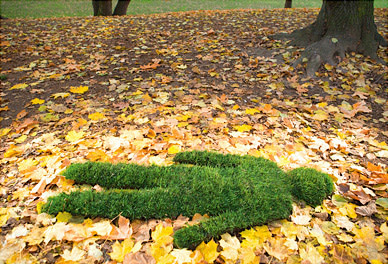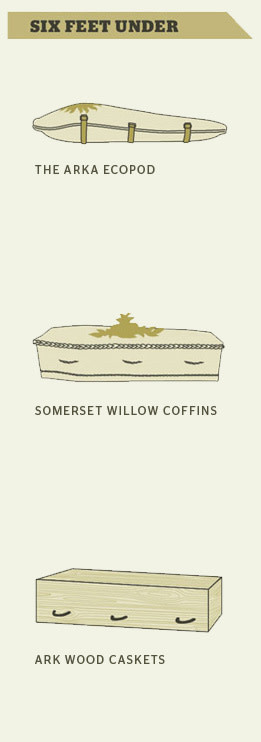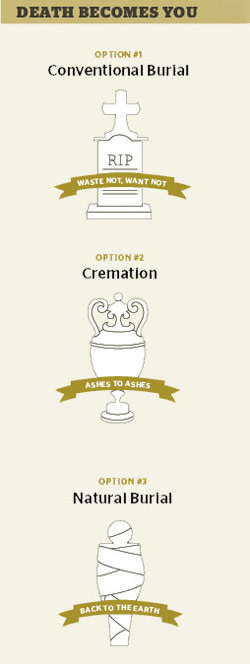Green: It’s the New Black

You drove a Prius and bought carbon offsets. Whenever you could, you biked to work. You schlepped cloth bags to the grocery store—most of the time. You actually gave Greenpeace canvassers the time of day, and you forked over hard-earned cash to the Sierra Club and the Nature Conservancy. You ate countless pounds of chard from a one-acre, biodiesel-powered organic farm in Troutdale. You installed solar panels and channeled your gutter downspouts into rain barrels. You treated the weekly recycling sort as a commandment from Gaia.
Well done. Now, however, things have changed: you’re dead. Whither your hard-earned green credentials now that relatives are pawing through your organic cotton wardrobe and divvying up your certified-forest-friendly furniture?
Do not despair. Well, actually, go ahead—it’s never fun to contemplate your own mortality. Especially when Americans’ burials consume, every year, nearly a million gallons of toxic embalming fluid, over 90,000 tons of energy-intensive steel, and more than 30 million board feet of wood, much of it tropical hardwood harvested and imported for caskets. But for those who want to ease the environmental damage done in the name of their own passing, there is some good news: sustainable practices and products are slowly infiltrating the behemoth American funeral industry, making it possible to reduce the carbon footprint of your final act. While a state-of-the-art natural burial—in which a body is allowed to biodegrade in a parklike setting to become, essentially, human compost—isn’t widely available in Portland, there are plenty of options for “going” green. But like so many aspects of this particular inevitability, greening up your own death requires a little gloomy research—but, as a bonus, you get to shop for some cool, cutting-edge consumer goods. Not that you’ll actually get to enjoy them, but still.
{page break}

Will Power
At the most basic level, planning a green funeral is like planning any funeral: if the to-be-deceased doesn’t make his or her wishes known in writing, a haphazard and unsatisfying memorial is likely to ensue. Most standard estate planning approaches, including popular software like Quicken WillMaker Plus, build in memorial planning. Simply specify your green wishes—like a desire to forgo embalming and use an environmentally friendly casket—in those plans.
Portland is home to what claims to be the nation’s foremost distributor of biodegradable coffins. The Natural Burial Company (3954 N Williams Ave, 503-493-9258, naturalburialcompany.com) stocks a wide variety of green caskets and cremation urns (see “Six Feet Under”) and offers workshops and private consultations. Owner Cynthia Beal got her start in the natural-foods industry and brings an inclusive attitude to the enviro-death issue. “After seeing how divisive natural foods could be,” she says, “the last thing I want is a bunch of green-burial righteousness.” The company’s website and Beal’s own Be a Tree site (beatree.com), which excerpts her forthcoming book on green burial, provide a wealth of links to green-burial organizations. Be a Tree’s open comments thread also hosts a lively discussion on many aspects of estate planning and funeral arrangements.
As far as service providers are concerned, Portland’s funeral homes are becoming increasingly sensitive to worries about carbon footprints and chemical use. “In the last year or two, more and more people have been asking those questions,” says Erin Phelps of Portland’s Omega Funeral & Cremation Service (223 SE 122nd Ave, 503-231-6030, omegaservices.com). “Families are purchasing biodegradable urns and asking about burials that are a little more natural.” Phelps points out that, in most cases, the law does not require embalmment, which means funeral homes should be willing to work with families who prefer chemical-free undertaking. Funeral homes also are required to accept caskets purchased elsewhere, or even homemade receptacles—meaning there’s no need for the deceased’s loved ones to page through catalogs of the kind of overpriced, sealed-steel monstrosities the American funeral industry is notorious for favoring. “You can wrap the body in a sheet,” Phelps says. He adds that prospective customers also can seek out funeral homes that work with Islamic and Jewish communities—those faiths require quick, embalmment-free funerals and simple caskets or shrouds.
{page break}
Pushing Daisies
In recent years, the ultragreen practice of natural burial has attracted some media attention. The idea of rejoining the ecosystem by peacefully decomposing in a designated natural area would certainly appeal to any environmentalist.

However, the United States lags behind other countries—notably the United Kingdom—in the development of natural-burial areas. The Green Burial Council (greenburialcouncil.com), an American certification agency, provides more information on natural burial, and the Natural Burial Company’s site includes links to existing natural-burial grounds in the States. Portland seems like an ideal market for natural burial, but right now the council certifies only one cemetery in the metro area: Hillsboro’s Valley Memorial Park (503-648-5444). Valley Memorial, started as a traditional cemetery in the 1950s, decided three years ago to set aside some of its 40 acres—parcels close to wetlands, streams, and hiking trails—for less intrusive development. That means graves dug by hand, mandatory use of biodegradable coffins, and use of natural features, like on-site boulders or newly planted trees, instead of traditional headstones. “It came about through our desire to leave these areas in a more serene state, and not turn them into a typical cemetery landscape,” says David Schroeder, Valley Memorial’s executive director. “We scratched our heads for a long time. When we started to learn more about natural burial, the lightbulb finally went off.”
Dust in the Wind
Even as demand for natural burial increases, cremation remains the default choice for those seeking a lower-impact end. According to Beal, it’s still important to shop around. “You want to find the cleanest crematory you can,” she says. According to Be a Tree, 80 percent of US crematoria use dated equipment—so look for a business that uses modern, fuel-efficient ovens built within the past 10 years. Mercury emissions from incinerated dental fillings pose a particular problem: in the United Kingdom, cremation accounts for about 16 percent of airborne mercury. However, Beal writes, “Green cremation ‘wins’ over an embalmed body and nondegradable casket system any day.”
Ashes to Ashes …
If you choose cremation, now comes the fun part: the disposition of your remains. A number of green-hued options present themselves. You can choose a sustainable urn (available at the Natural Burial Company), which can be buried on any private property, or, with permission and given certain restrictions (some national parks forbid the practice), ashes can be scattered on public lands. Alternatively, you can hire a gardener to design an outdoor memorial on your own property, or fund a Friends of Trees (friendsoftrees.org) planting. If you prefer to disperse into a river, lake, or sea, you might consider an urn made out of water-soluble Himalayan rock salt. It comes in a fetching shade of pink.
Most important, as you contemplate how to green up your exit, take heart: death is, after all, integral to the natural systems environmentalists revere. And once you’ve truly reunited with nature, you won’t have to worry so much about global warming anymore.
